A Wader Spectacular tour today. We were lucky with the weather, with rain overnight clearing through, the odd shower – and rainbow – still while we were on our way to Snettisham, but then dry during the whole day. The sun even came out in the afternoon, even if it remained rather blustery.
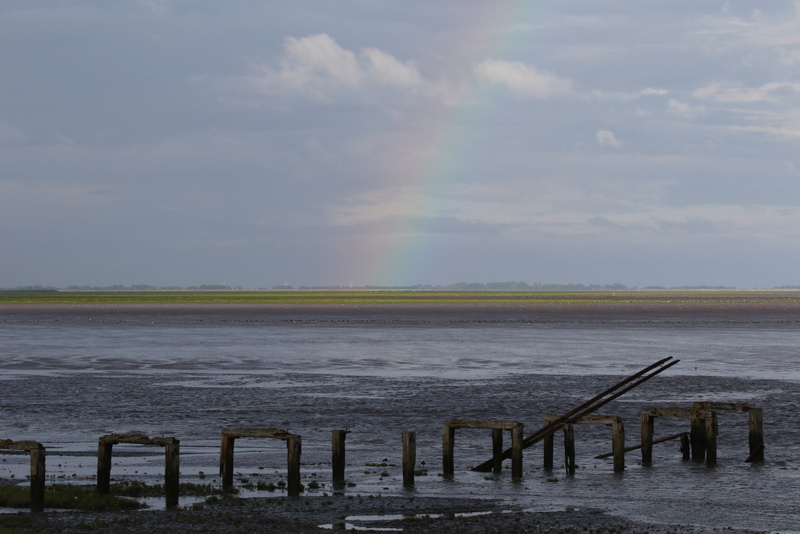 Rainbow over Snettisham
Rainbow over Snettisham
The tide was already coming in fast when we arrived. We stopped on the seawall to scan through the smaller waders on the mud along the near shore. There were lots of Ringed Plovers gathered and a single Grey Plover already in winter plumage with them. A moulting Sanderling was turning silvery grey above but still with lots of much darker blackish feathers mixed in, and little groups of Dunlin were running around taking advantage of the last chance to feed before high tide.
A flash of a white rump alerted us to two Curlew Sandpipers flying in along the shoreline. Unfortunately they didn’t land, but whipped up and over the bank towards the pits. We would look for them later, once all the waders were off the Wash.
We walked quickly along the path, following the tide in. The flocks of waders were getting pushed further and further up on the mud, the groups seeming to flow away from the rising water. More birds were flying in all the time, having been pushed off the beach further up along the coast. The Oystercatchers were gathering on the mud closest to us, shining bright in the morning sunlight. A great sight.
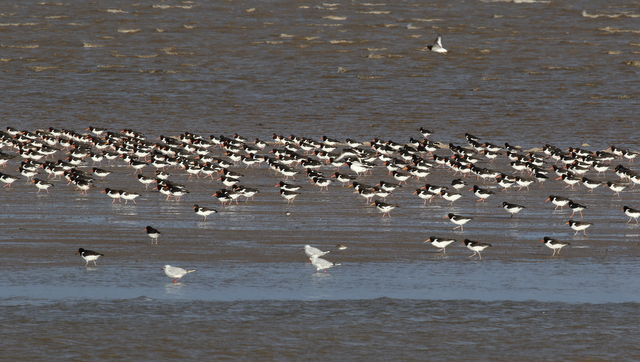 Oystercatchers – gathering on the mud nearest to us
Oystercatchers – gathering on the mud nearest to us
A little further over, we could see lots of Bar-tailed Godwits too. The mass of Knot were further over, towards the back of the bay. In amongst them all, we could see smaller numbers of other species, including Dunlin and Curlew. As the tide rose, they were all getting increasingly concentrated into a smaller and smaller area of remaining mud.
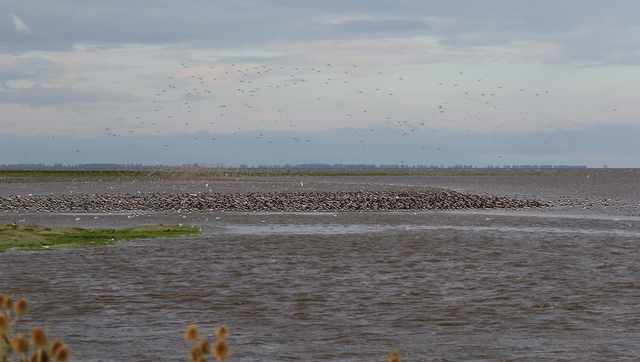 Waders – the flocks are concentrated into a small area of remaining mud
Waders – the flocks are concentrated into a small area of remaining mud
After a while, the birds had no option but to start to come off the mud. The Oystercatchers gave up the fight first, peeling away in smaller flocks, lines of birds making for the safety of the pits behind us.
Eventually the Knot took flight too, bringing most of the other waders up too. The sight of such an enormous number of birds whirling around in the sky is what the Wader Spectacular is all about and today was a good one. There were vast numbers of birds in the sky – perhaps 40,000 Knot alone. They wheeled around overhead, nervous, uncertain over whether to try to remain out on the Wash for a bit longer or try to find safety on the pits or fields beyond. When they flew higher, they looked just like huge grey clouds; when they came lower overhead, we could hear the whirring of thousands of wings above the wind. Stunning!
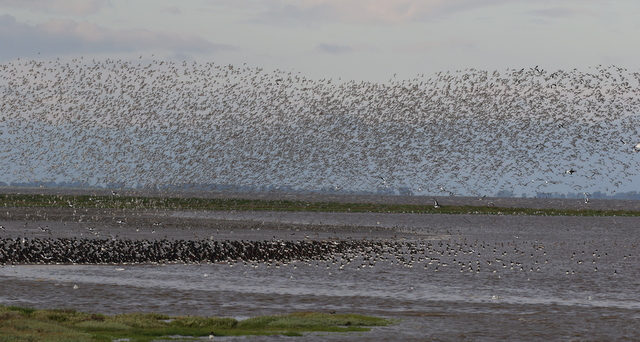
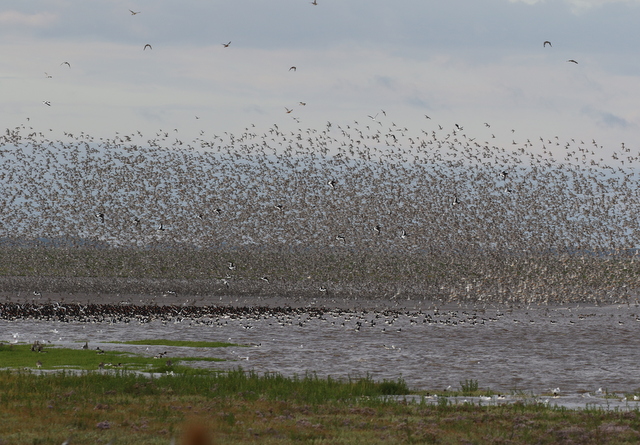
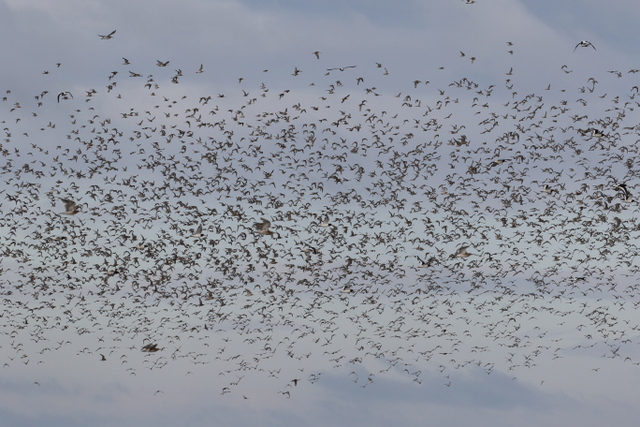
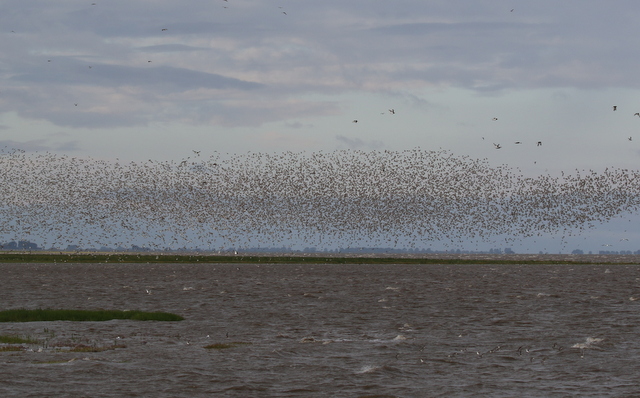
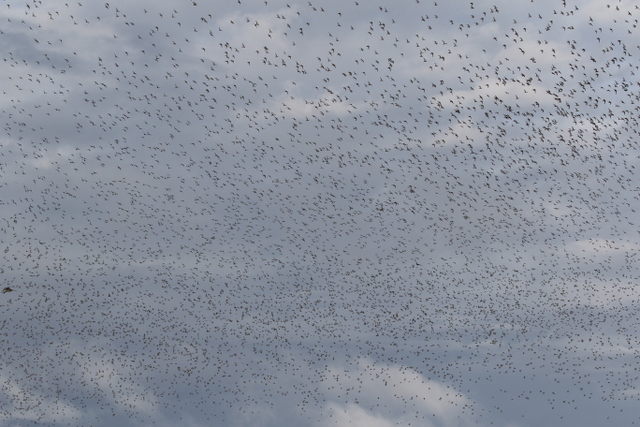 Waders – 10,000s of birds coming off the Wash
Waders – 10,000s of birds coming off the Wash
We stood and watched in awe as the flocks whirled overhead. Eventually, with the mud disappearing, the Wash was mostly cleared of birds and we set off to the hides to look through the hordes. As we did so, a Wheatear flicked up from the path and landed on a fence post just behind us.
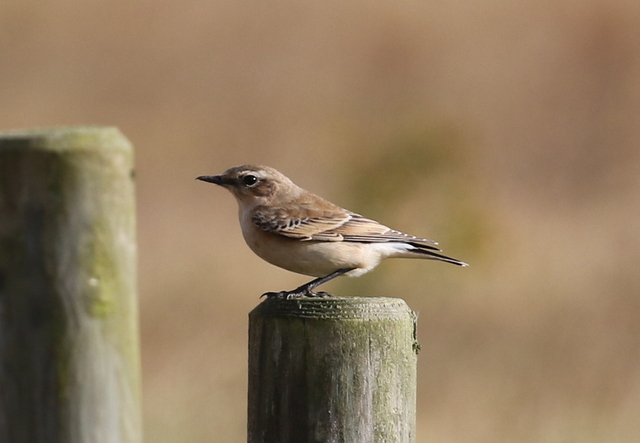 Wheatear – on the way to the hide
Wheatear – on the way to the hide
Round at South Hide, there were loads of Black-tailed Godwits and Oystercatchers gathered on the islands, but not so many smaller waders as in recent weeks. What was lacking in numbers here was more than made up for in variety and made the task of searching through the smaller ones much easier.
The first to appear was a Little Stint, running along the gravel shore just in front of the hide. By the end of our search, we found at least four of them here. It was great to see them side by side with Dunlin, noting their smaller size, shorter bill and brighter white face and belly.
 Little Stint – one of at least four here today
Little Stint – one of at least four here today
The Curlew Sandpipers appeared next, probably the same two we had seen coming off the mud earlier. Smart juveniles, with peachy orange breasts and neatly scaled upperparts. Notably larger than the Dunlin, with a longer more evenly downcurved bill. We were treated to great views as they fed along the edge of the water down below the hide. At one point we even had Curlew Sandpiper, Little Stint and Dunlin all in the same view – a great opportunity for comparison.
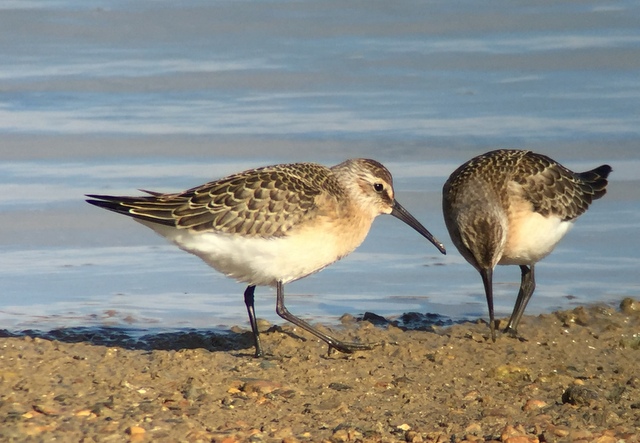 Curlew Sandpiper – two smart juveniles
Curlew Sandpiper – two smart juveniles
There are a good number of Greenshank here at the moment too, and we were treated to great close up views of several of them from the hide. A Spotted Redshank appeared with them, in winter plumage now, silvery grey above and white below but still with that distinctive long, needle-fine bill. A little further out, in the deeper water, we found some more Spotted Redshanks, include one much duskier grey-brown juvenile.
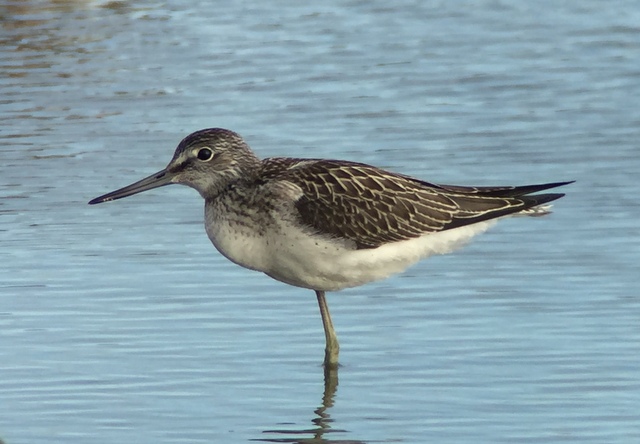 Greenshank – great views from the hide
Greenshank – great views from the hide
Once we had exhausted the possibilities here, we walked back round to Shore Hide. The bigger numbers of waders were roosting up this end of the pit today, with the vast flocks of Knot packed tightly onto the islands, spilling over into the water. There were also more Black-tailed Godwits here and lurking down in amongst the throng were several Dunlin and a few Turnstone.
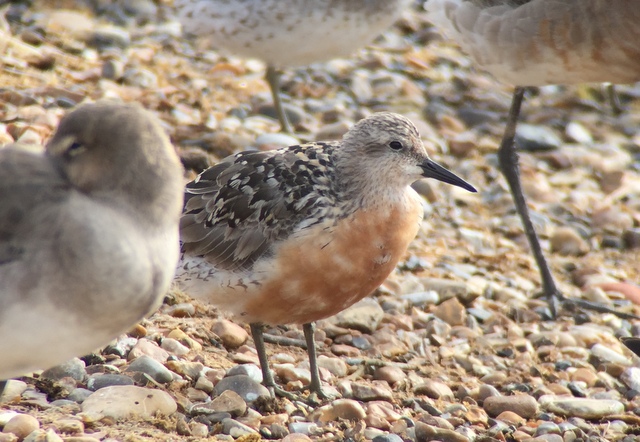 Knot – many still sporting the remnants of orange summer plumage
Knot – many still sporting the remnants of orange summer plumage
The waders are always nervous when they are roosting on the pit, perhaps more vulnerable to a rapidly approaching predator here compared to the vast open mud out on the Wash. When the flocks of Knot on the islands to our left suddenly burst into the air, we noticed why a couple of seconds later as a juvenile Peregrine through shot across the water in front of the hide, leaving bedlam in its wake.
As the tide started to go back out, and the mud reappeared, we made our way out to the shore of the Wash again. The Oystercatchers started to appear quite quickly, drifting back out in lines and gathering on the wet mud, but the other waders were slower to return today. A couple of large flocks of Knot came off the pit, streaming low over the bank and out across the mud. A Little Stint appeared on the edge of the mud in front of us.
We made our way back to the car, then drove round to Titchwell. After a very welcome break for an early lunch, we headed out onto the reserve. The grazing meadow ‘pool’ was flooded with shallow puddles today, but still not as much water as there should be here. There were several Lapwing dozing on the drier ground and a single juvenile Ruff asleep next to one of the pools. We stopped to admire a Stock Dove which was walking around on the mud.
As we walked on along the path, we could hear Bearded Tits ‘pinging’ behind us. We turned to look, but it seemed too windy for them to be perching up today. We got as far as the reedbed pool, and stopped to scan through the ducks. A Great Crested Grebe was swimming across the back with its fully grown but still stripey faced juvenile. We could hear more pinging behind us and turned just in time to see one fly across the reeds on the corner of the saltmarsh. Then a pair of Bearded Tits appeared and perched up in the top of the reeds for a few seconds, before dropping down out of view. More pinging followed and all three flew across the main path behind us and dropped down into the main reedbed.
There didn’t seem to be as many waders on the Freshmarsh as in recent weeks, fewer Avocets and Black-tailed Godwit, but still a good variety. We stopped to scan from Island Hide and found the two juvenile Curlew Sandpipers over in the corner. A Lapwing on the mud in front of the hide looked irridescent in the afternoon sunshine.
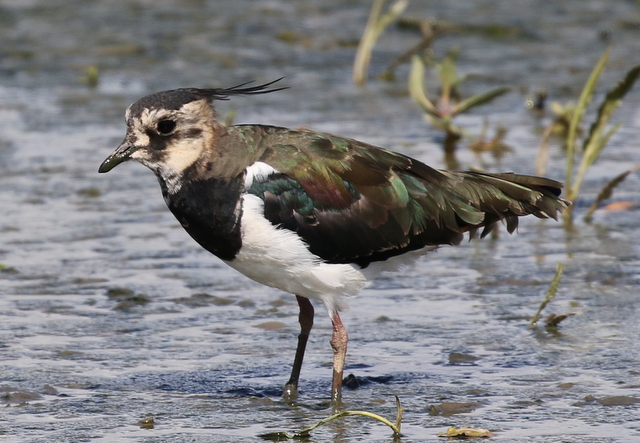 Lapwing – looking irridescent in the sunshine
Lapwing – looking irridescent in the sunshine
There are still good numbers of Ruff here too, lots of pale winter plumage adults, grey brown above and white below, plus a few much browner juveniles. We had better views of these and the Curlew Sandpipers from up on the main path.
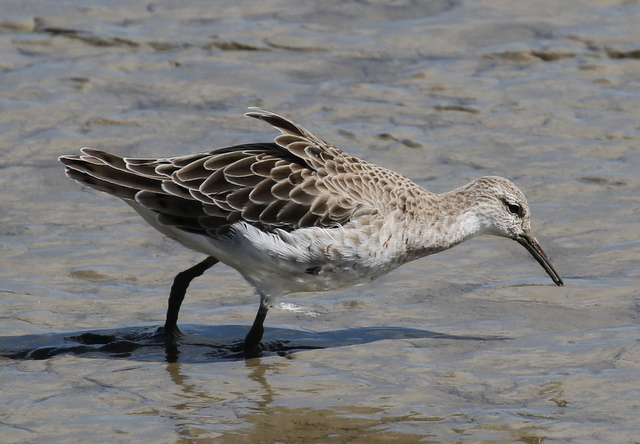 Ruff – a mostly winter plumaged male
Ruff – a mostly winter plumaged male
There were plenty of gulls and terns roosting on the islands. From Island Hide, we had picked out a couple of Sandwich Terns among the Common Terns, one of which woke up long enough to flash its yellow-tipped black bill. From up on the bank, we found a Mediterranean Gull in with the Black-headed Gulls, an adult in winter plumage with white wing tips and black bandit mask. Round at Parrinder Hide, we could see a Yellow-legged Gull asleep with the Lesser Black-backed Gulls.
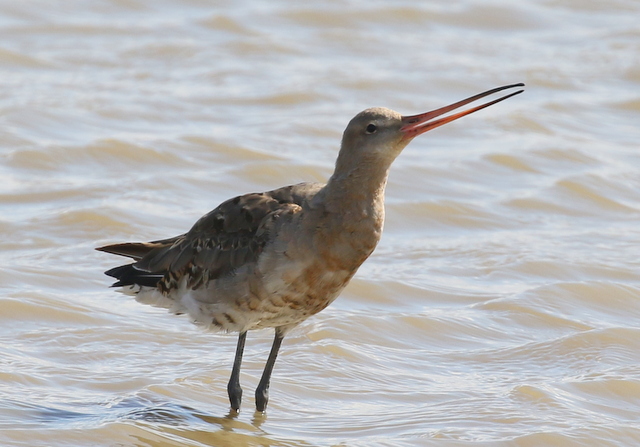 Black-tailed Godwit – moulting into winter plumage
Black-tailed Godwit – moulting into winter plumage
A scan around the islands from Parrinder Hide located the Little Stint, on its own along the muddy shore of one of them, our fifth of the day. There were a few more Black-tailed Godwits here, but fewer than recently roosting on the island in front of the hide. A quick look at Volunteer Marsh produced a stunning summer plumage Grey Plover, with black face and belly.
After an early start and spending most of the morning at Snettisham, it was just a brief visit to Titchwell this afternoon. Having failed to find any Spoonbills on the freshmarsh, we decided to head back quickly to the Autumn Trail. Patsy’s Reedbed was rather quiet, apart from a selection of moulting ducks and a few Sand Martins and House Martins hawking over the water. Out on the saltmarsh from the Autumn Trail extension we found what we had been looking for – three Spoonbills doing what they like to do best, sleeping!
Then it was time to make our way back. There was a good selection of insects out today, and several dragonflies in the more sheltered areas – Migrant and Brown Hawkers, and lots of Common Darters. We had to be careful not to tread on any of the Bloody-nosed Beetles, several of which were walking across the paths and boardwalks oblivious of the feet passing overhead.
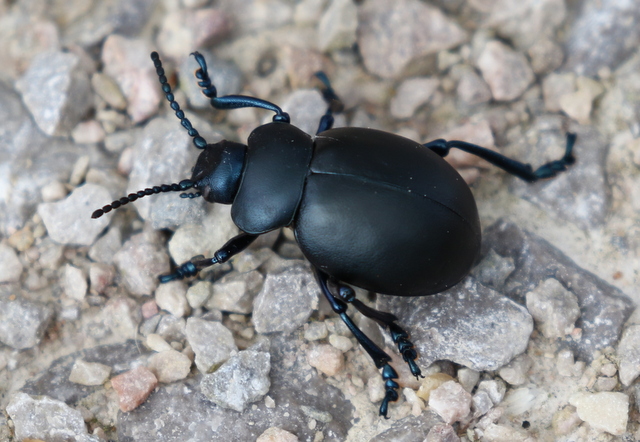 Bloody-nosed Beetle – we had to avoid lots on the paths today
Bloody-nosed Beetle – we had to avoid lots on the paths today
The walk back along Fen Trail to the Visitor Centre produced a couple of Reed Warblers sheltering from the wind in the sallows. A passing tit flock had a couple of Chiffchaffs in with the Long-tailed Tits. Then it was a welcome opportunity to put our feet up when we got back to the car for the drive home.
















